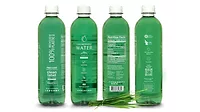Beverage Beat
Consumer interest in non-alcohol peaks in January
Celebrities, international brands look to capitalize on growing alcohol-free interests

Image courtesy of ISH
I recall about a decade ago when a celebrity was talking about his resolution to abstain from alcohol for the month of January as a way to detox from the holiday celebrations that preceded it. It was probably the first time I had heard of what commonly is known as Dry January. Beyond this abstaining month, 12 years ago was the founding of Sober October, founded as an Ocsober fundraiser in 2010 by Australian youth health organization Life Education.
There have been other attempts to expand the alcohol-free months, including Dry July or Sober September. Yet, recent research from global eCommerce accelerator Pattern shows that U.S. consumers are more eager to participate in Dry January than its October counterpart.
Based on searched data from U.S. Amazon shoppers from 2019 to 2022, Pattern’s analysis found that January was the month with the highest interest from shoppers for non-alcohol beverages. October 2020 did see a bump in searches on Amazon with non-alcohol beverage interest up 14%. However, this was much lower than the 47% increase for January 2020.
When comparing 2020 with 2021, interest in non-alcohol beverages on Amazon saw a 3% year-over-year increase for January. Meanwhile October was down 45% compared with the previous year. Pattern attributes this shift to the 10 year observance of Sober October 2020 in the United States and likely having a larger than normal marketing push.
Video courtesy of Betty Buzz
“With Dry January increasingly capturing the interest of consumers, it’s vital for alcohol alternative beverage brands to generate brand affinity and awareness early,” says Hamilton Noel, data scientist at Pattern. “The holiday season, beginning with Sober October, is the perfect opportunity to increase budgets for marketing and advertising to grab consumers attention. That way, once they are ready to make New Year’s resolutions, your brand is top of mind for going dry.
“It’s also important to note that as supply chain issues continue to impact brands, globally,” Noel continues. “Beverage brands should make sure to stay tightly connected with their data science teams to understand where consumer demand is heading, as well as their manufacturing partners to ensure they’ll have the right amount of inventory on hand for the Q1 surge.”
The beverage market has seen no shortage of participants in the no-alcohol arena. For instance, actress Blake Lively has seen her upstart brand Betty Buzz expand its presence in its inaugural year. The alcohol-free sparkling mixer already has entered 8,000 retail locations alongside direct-to-consumer directives.
Available in five flavors ― Tonic Water, Sparking Grapefruit, Meyer Lemon Club Soda, Sparkling Lemon Lime and Ginger Beer ― Betty Buzz beverages are made with real juice and natural flavors, do not include artificial flavors, colors, or sweeteners, are non-GMO, and gluten free, the company says.
The non-alcohol market also is drawing attention outside of the United States. In anticipation of holiday entertaining, Denmark-based ISH is launching its line of hand-crafted non-alcohol (NA) sparkling wines, spirits, and cocktails across the United States. The ISH portfolio includes two non-alcohol sparkling wines; three NA spirits that mimic Rum, Gin and Tequila (named Caribbean Spiced Spirit, London Botanical Spirit and Mexican Agave Spirit); and three canned NA cocktails (Spritz, G&T, and Lime Daiquiri).
Morten Sørensen created ISH after he chose to take a 100-day break from drinking alcohol, which he notes wasn’t a challenge, but finding alternatives was.
“I wanted to be a more mindful drinker and while out socializing with friends, I didn’t want another cranberry-ginger ale,” Morten stated. “So, I decided to create a new line of non-alcoholic drinks to make it easy for anyone to be a mindful drinker. Everyone deserves to have a great drink whether or not it contains alcohol. ISH makes that possible.”
As interest in alcohol-free is set to rise in the coming months, consumers will have no shortage of options. The question is are brand owners prepared for the likely increased interest for these products.
Looking for a reprint of this article?
From high-res PDFs to custom plaques, order your copy today!





